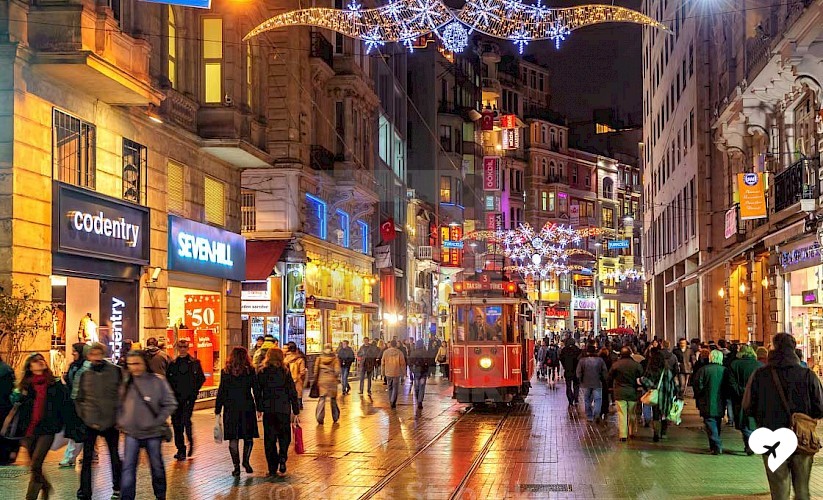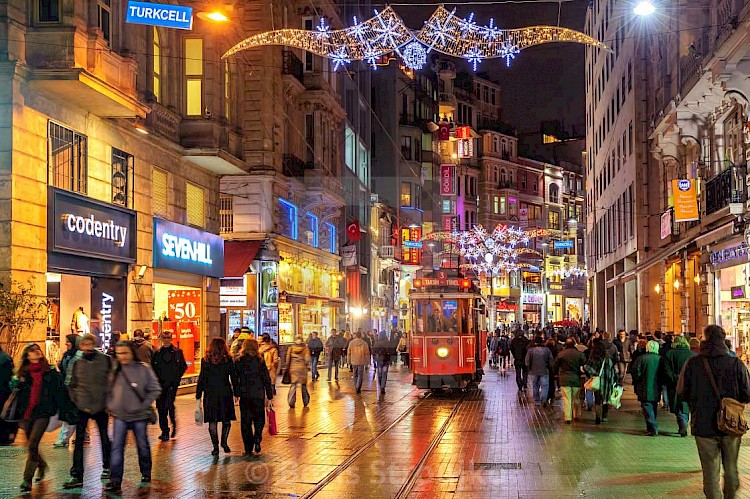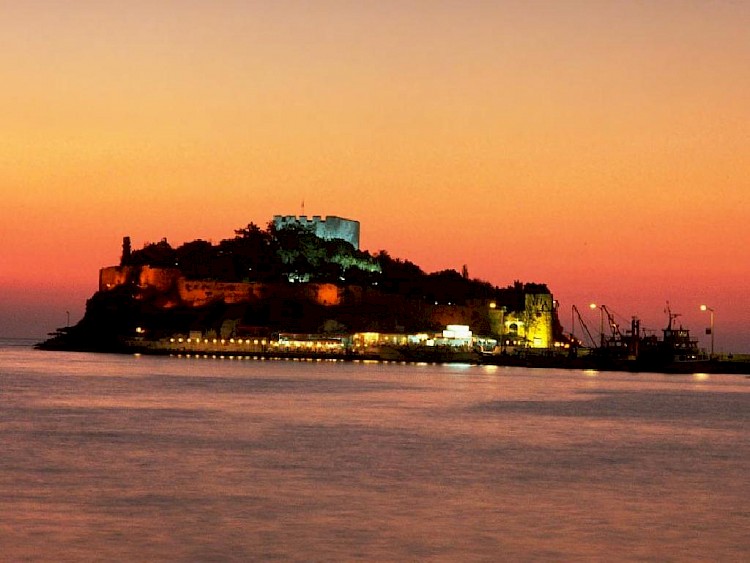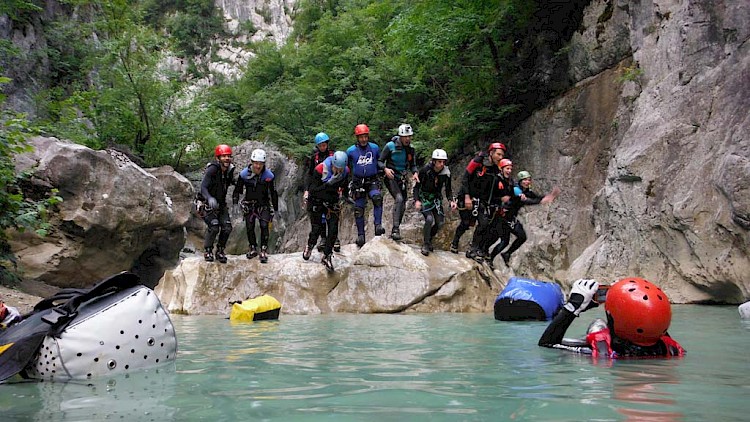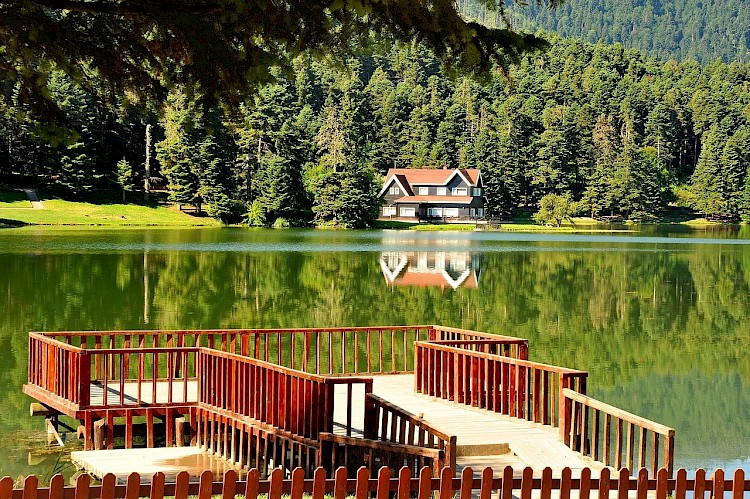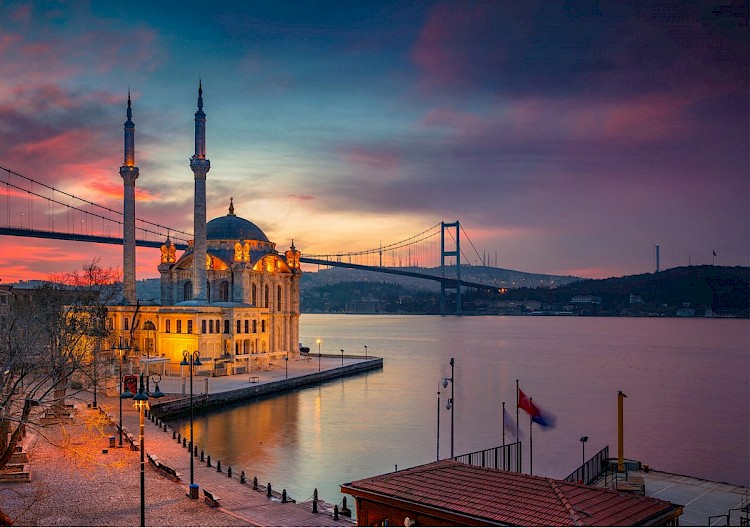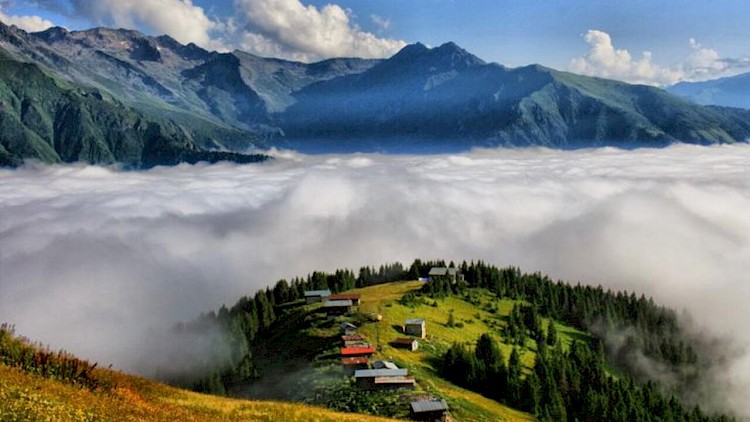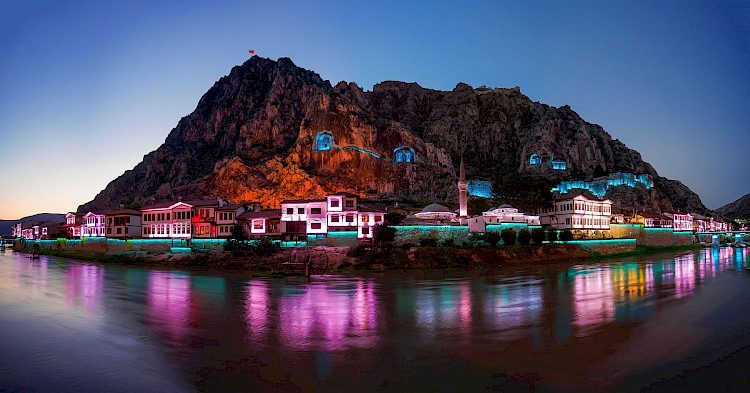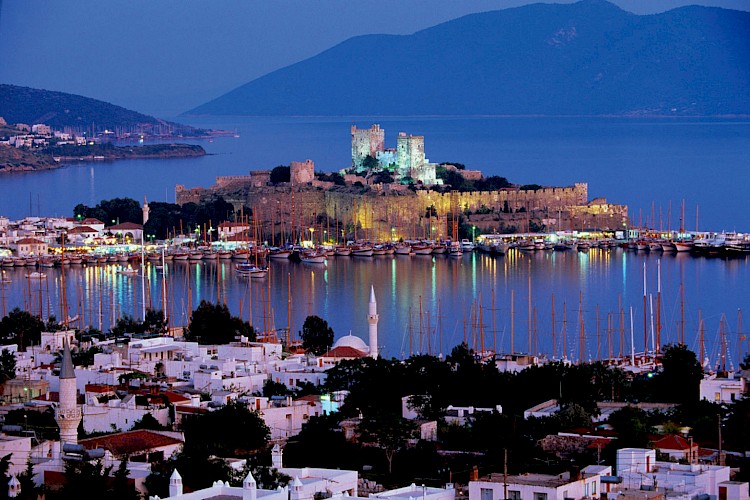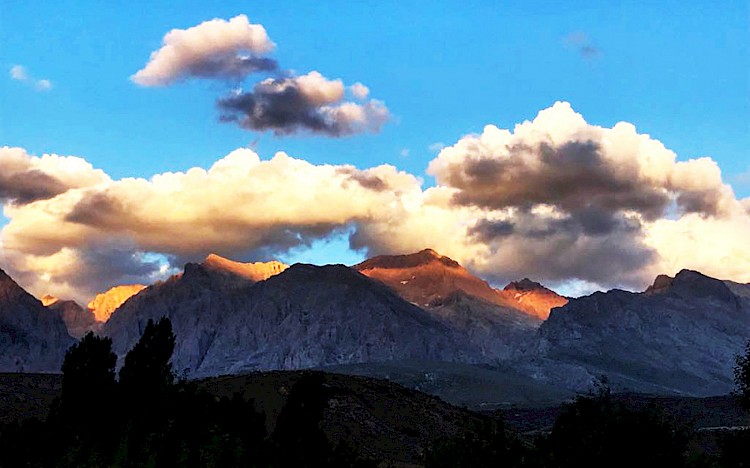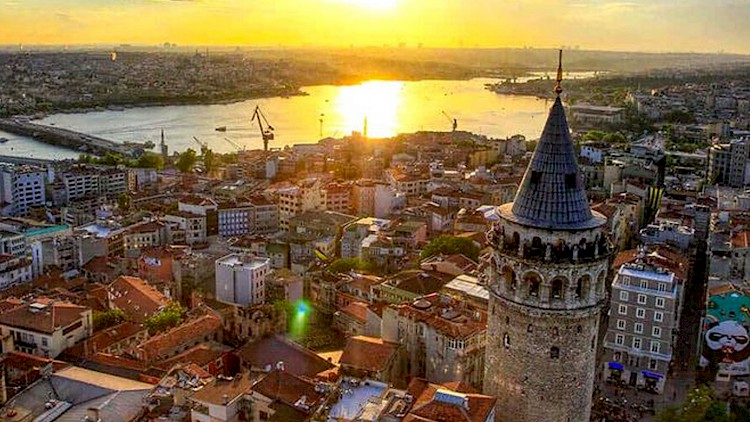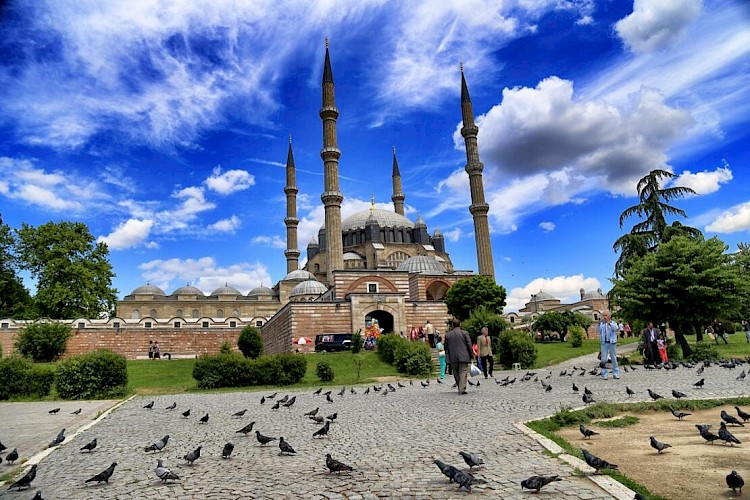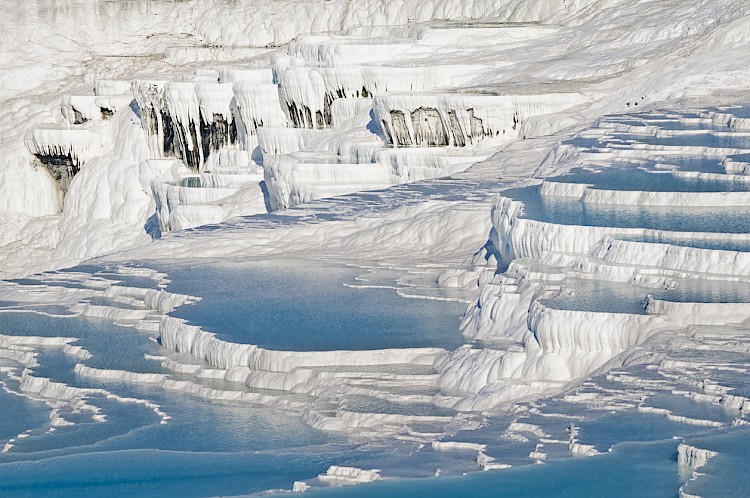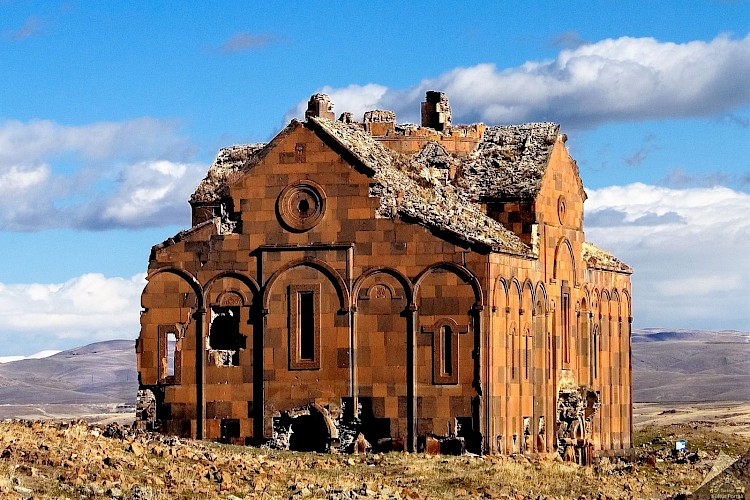Every landscape of Turkey forms the backdrop and context for people and events, with perhaps the most thrilling aspect of travelling the ability to become an active participant in this landscape.
As in all human interactions the basis is one of equality in the roles of host and guest. This defining mutual respect and a shared sense of responsibility as the guiding principle in an adventure where the parties involved are, by definition, different in their outlook and way of life. When Turks entered the tourism arena- that was not so long ago-, they were armed with a tradition of hospitality rather than sophisticated facilities or a mentality for providing service.
Although Turkey now has an excellent tourism infrastructure, the motivation of most Turks remains one of sincerity and courtesy. The desire of Turks to feel understood and valued, to communicate and learn about people from other lands is a much more important motivation. Interpret their enthusiasm to interact with you from this perspective. They prefer to make long-term acquaintances by spending time together, exchanging cards, letters and gifts rather than receive payment or large tips for any help granted. This attitude may change as the tourism industry develops further in the coming decades, and much still depends on the visitors, but for now the sweetness of the Turkish people is unspoiled.
Here are some tips about social graces and conduct which may be useful in interpreting the goings-on around you, helping you to enjoy your participation in this social landscape even more. Greetings involving welcomes, handshakes, hugging and kissing on both cheeks, followed by a "How are you? How is the family? How is your health? How is business?" are important rituals. It is expected that everyone will inquire after the health and well-being of everyone else at first. During religious holidays, greetings are even more important. Young people visit and kiss the hands of elderly family members. Every friend and family is visited in order to renew bonds and kinship. Children receive pocket money and gifts, and responsibilities for social charity are fulfilled. Like elsewhere, these are joyous occasions. However, celebrations emphasize traditional, social and spiritual aspects, and a certain amount of decorum in action and appearance is expected from everyone.
İstanbul / İstiklal Caddesi
A dinner invitation to someone’s home is a special honour. At the dinner table it is customary for the hostess to offer additional servings many times and with great insistence. The guest is expected to accept the offer after several such offers. Dinners are leisurely affairs, to be savoured slowly along with the delicious home-cooked food. Sometimes, guests bring flowers or sweets to such occasions. During a typical after-dinner coffee, tea, candy, cookies, pastries and fruit are served.
In business relationships the whole affair is conducted as a social occasion, and completed with greetings and sharing coffee, tea or food and drinks, depending on the extent of the business. Even in ordinary shopping a lot of personal information is exchanged between the vendor and the customer, setting the stage for everyone to fulfil their various responsibilities. Bargaining is not a simple game of negotiation between adversarial parties but part of socialization and friendly chitchat to confirm the non-adversarial nature of the activity.
Turkey: A Land for All Tastes
In Turkey you will experience an incredible diversity in nature, culture, history, beliefs and ideas.
AS a bridge between Europe and Asia, Turkey has so much to offer visitors: breathtaking natural beauty, unique historical and archaeological sites, steadily improving hotel and touristic infrastructure and a tradition of hospitality and competitive prices. Therefore, it is not surprising that Turkey has become one of the world’s most popular tourism destinations.
Aydın / Kuşadası
In Turkey you will experience an incredible diversity in nature, culture, history, beliefs and ideas. This in itself may not be a challenge for the seasoned traveller. After all, diversity is the most prized feature of favourite destinations. In Turkey this diversity is rich enough to challenge even the most experienced eye because it is packed into tight spaces with abrupt changes of scenery. This is why people sometimes describe the Turkish landscape as a "symphony of sounds, smells and people in the most unlikely combinations of appearance and action".
Due to Turkey's diverse geography, one can experience four different climates in any one day. This rectangular-shaped country is bordered on three sides by three different seas. Its shores are laced with beaches, bays, coves, ports, islands and peninsulas. Turkey is also blessed with majestic mountains and valleys, lakes, rivers, waterfalls and caves perfect for winter and summer tourism as well as sports of all kinds. Fans of skiing, mountain climbers, trekkers, hikers and hunters can all enjoy new and unforgettable experiences in Turkey. The country is rich in hot springs, healing waters and mud baths, which are highly recommended by the medical authorities as a remedy for many diseases. But Turkey is above all a huge open-air museum, a repository of all the civilisations nurtured by the soils of Anatolia.
Kastamonu / Valla Canyon
Besides its great sights and monuments, Turkey offers unlimited opportunities for leisure and pleasure. Majestic mountains are ideal for climbers, hikers, skiers and paragliders. There are over 8000km of coastline laced with picturesque bays and coves offering not only unique spots for summer holidays but also exciting opportunities for scuba diving, sailing, parasailing and cruising. Year-round sunshine destinations are accessible in Turkey, while there is plenty of snow in others. There is a solid and expanding tourism infrastructure, one of the world’s healthiest cuisines and an extremely hospitable people. Seniors, historylovers, yachtsmen, mountaineers, young parents with toddlers and business people who look for new adventures can all find something special in Turkey.
A Unique Geography Connecting East to West
Turkey is like a mosaic made up of many different reliefs and formations: parallel mountain ranges, extinct volcanoes, plateaux fissured by valleys and plains.
TURKEY is a vast peninsula, covering an area of 780,000 sq km and linking Asia to Europe through the Sea of Marmara and the Straits of İstanbul and Çanakkale.
It is characterized by a central plateau surrounded by chains of mountains to the north, west and south and a rugged mountainous region in the east with an average elevation of 1050 metres. The Northern Anatolia mountain range and the Taurus range in the south stretch like arcs, becoming ever denser in the east. In the west, however, the mountains descend gently towards the sea.
Turkey is like a mosaic made up of many different reliefs and formations: parallel mountain ranges, extinct volcanoes, plateaux fissured by valleys and plains.
Bolu / Yedigöller
Surrounded by seas on three sides, it is placed in the temperate climate zone. The climate varies considerably from region to region, however: a temperate climate in the Black Sea region, a Mediterranean climate on the southern coast and the Aegean, a continental and arid climate on the central plateau, and a harsh mountain climate in eastern Turkey. Because of these variations in climate, the fauna and flora are some of the richest in the world.
ere are more than 10,000 species of plants in Turkey, 20% of which are endemic. Turkey is home to a number of ornamental flowers, the most notable being the tulip.
There are more than 10,000 species of plants in Turkey, 20% of which are endemic. Turkey is home to a number of ornamental flowers, the most notable being the tulip. Bulbs of these plants were brought to Vienna from İstanbul in the 1500s, beginning the craze for tulips in England and the Netherlands. By 1634 the interest in tulips had grown so intense that in Holland ‘tulipomania’ emerged, with individuals investing money in tulips as they do in high-tech stocks now. This period of elegance and amusement in 17th-century Turkey was also symbolized by this flower, giving the era the name "the Tulip Age".
urkey has a great variety of wild animals, with around 160 species of mammals. The forest belt to the north is home to grey bears, while the south is home to wild goats. Sea turtles and seals play in the waters of the Mediterranean and the Aegean. Just as in other parts of the world, some species have become extinct or are on the verge of extinction. There are 418 species of indigenous or migratory birds, some of which are extinct in Europe, such as the black vulture. The most important species for environmentalists is the "bald Ibis", a peculiar bird with a bald pink head and drooping feathers.
There are 418 species of indigenous or migratory birds, some of which are extinct in Europe, such as the black vulture.
If you take a cross-section along the east-west axis, you will encounter the rugged, snow-capped mountains where winters are long and cold; the highlands where the spring season with its rich wildflowers and rushing creeks extends into long, cool summers; the dry steppe with rolling hills, endless stretches of wheat fields and barren bedrock that take on the most incredible shades of gold, violet and cool and warm greys as the sun traverses the sky; the magical land of fairy chimneys and cavernous hillsides; and eventually the warm, fertile valleys between cultivated mountainsides of the lace-like shores of the Aegean where nature is friendly and life has always been easy.
A north-south cross-section begins with the lush, temperate zone of the Black Sea coast, well protected by a chain of high mountain ranges, cultivated in hazelnuts, corn and tea (which will become a part of the daily ritual during your stay here). High passes and winding roads offer breathtaking views of the Black Sea, leading to highlands and steppe, with orchards tucked into the foothills of lower mountains; then on to the vast Konya plain, and up the Toros (Taurus) Mountains into coniferous forests, which eventually descend to a scrubby maquis fragrant with bay leaves and oregano as the Mediterranean coast approaches. Then, if you turn east, passing banana plantations and cotton fields, you will come to the desert-like part of Turkey. Just north of Syria, the earth displays all the textures and shades of brown imaginable. In short, for every two to four hours of driving, you find yourself in a different geographical zone with all the attendant changes in scenery, temperature, altitude, humidity, vegetation and weather.
e bucolic, rural scenery radiates with sincerity and health, enhancing the traveller's experience.
Turkey’s landscape has the combined characteristics of the three oldest continents of the world: Europe, Africa and Asia. It has an ecological diversity surpassing any other place along the 40th north latitude. This diversity is reflected in the intermingling of all species of animals just as they were found before the geological separation of the land masses occurred, but whose habitats are now dispersed among these continents. Now it is possible to observe the yearly ebb and flow of nature as birds continue on their migratory routes twice a year. The flocks of storks and birds of prey convey a magnificent spectacle that you can watch from the hills of Çamlıca in İstanbul every fall. The flamingos nest in the river valleys of the Aegean and the Mediterranean and spend the winter in the saltwater lakes of the inlands. If you happen to be visiting Dalyan (or some other beaches along the Mediterranean) on a warm spring night in May, you will be sharing the sand dunes with one of the most delightfully shy creatures in the world, the sea turtle, which lays its eggs in the sand at this time of year.
Many such familiar fruits as cherries, apricots, almonds and figs also originate in Turkey. Humankind’s common ancestors are imagined to have evolved in different parts of the world – nevertheless, the depiction of Adam and Eve wearing fig leaves confirms a long-standing view of Turkey, with its abundance of figs, as an unspoiled Eden.
The bucolic, rural scenery radiates with sincerity and health, enhancing the traveller’s experience. In this, the motherland of wheat, the taste of ordinary Turkish bread surpasses any other when eaten freshly baked. The orchards, vineyards, and vegetable fields grow delicate and vibrant crops. As well as grains, staple crops include rice, cotton, sugar beets, tobacco and potatoes. This diversity and abundance of food products have contributed to the richness of the Turkish cuisine.
A Melting Pot of Peoples
İstanbul has the honour of having served as the capital of three successive empires – the Roman, the Byzantine, and the Ottoman. Anatolia itself became a crossroads of peoples, cultures and religions.
İstanbul / Ortaköy
Turkey has an extremely rich cultural heritage. Perhaps no other land has witnessed so many diverse civilisations over the last 11,500 years. After the great Mesopotamians, the Hittite and Urartian kingdoms flourished in Anatolia. The Ionian and Roman civilisations predominated the western Anatolia. İstanbul has the honour of having served as the capital of three successive empires – the Roman, the Byzantine, and the Ottoman. Anatolia itself became a crossroads of peoples, cultures and religions. Christianity, for example, thrived in these lands and Islam was glorified by the Seljuks and Ottomans. Occupying a highly strategic position on the world map, Turkey combines the wealth of the East and the West, offering a synthesis of the traditional and the modern, the old and the new.
Interpretation of the world scene today is based upon our understanding of what took place on this landscape, and which is now manifested in the ruins and monuments which adorn the landscape.
People of various origins came in waves and mingled with those already settled, each wave resulting in a new synthesis. Between 2000BC and 1500AD, this landscape was the centre of world civilisation. Interpretation of the world scene today is based upon our understanding of what took place on this landscape, and which is now manifested in the ruins and monuments which adorn the landscape.
In Anatolia, the settlement pattern is more or less as it was during the time of the ancient civilisations. There is a good chance that the road you are travelling on is the same one that great warriors of East and West trod, colourful caravans passed along, and couriers with mail or secret treaties galloped. Perhaps it is the same road travelled by St Paul and his companions, or by Sufis spreading their divine knowledge. Graceful aqueducts built by the Romans made urban concentrations possible. Bridges built by famous royal architect Sinan dot the countryside and are still used for the safe passage of goods and services. Caravanserais dating back to the Seljuk Empire of the 11th century offered sanctuary and relief to weary travellers. You can even stay in a caravanserai today, as several have been restored as hotels.
In addition to the historic edifices proudly displayed at such main archaeological sites as Troy, Pergamum, Ephesus, Miletus, Priene, Didyma, Aphrodisias, Heraclia, Caunos, Perge, and Aspendos, many coastal villages and towns are blessed with their very own Anatolian ruins on the outskirts. This is usually an ancient theatre commanding a spectacular view of the beach where villagers will tell you Cleopatra often swam. You don’t have to look far for the agora either. It is probably what it has always been – the local market place! Several villages are also privileged to have ‘sunken cities’ or ruins under the sea, which you can see if you look down into the crystal clear, turquoise waters as you swim. Until very recently the cave refuges in Cappadocia were used by villagers as cold storage or wine cellars.
The Anatolian hinterland will show you glimpses of ancient civilisations: the Hattians, the Assyrians, the Hittites, the Phrygians, the Urartians and the Lydians. From these civilisations come many familiar legends: the wealth of the Lydian King Croesus, King Midas with the golden touch and the Knot of Gordion that young Alexander was able to undo only with a blow of his sword.
Then there are the smaller sites, both sacred and ordinary, but with profound meaning: monasteries, tombs of saints, heroes, artists or poets, mosques, churches, walls, fortresses, palaces, fountains and cemeteries. The hillsides are covered with broken pieces of ancient pottery and even in more modern settlements you can see incorporated stones which may date back to antiquity.
A Country of All Faiths
As civilisations succeeded each other over a period of 11,500 years, they each left their religious legacy and, after the monotheistic domination of Anatolia, Islam, Christianity and Judaism co-existed in harmony.
ANY visitor to Turkey will be struck by the plethora and variety of religious buildings and ancient shrines. There are temples dedicated to ancient gods, churches of many denominations, synagogues and, of course, mosques. As civilisations succeeded each other over a period of 11,500 years, they each left their religious legacy and, after the monotheistic domination of Anatolia, Islam, Christianity and Judaism co-existed in harmony.
The Hattians, Hittites, Hurrians, Urartians, Ionians, Lydians and Phrygians had rich mythologies. Greek mythology began with the Iliad, the epic poem of Homer who was himself a child of Anatolia. Homer was deeply influenced by the cultural environment of his motherland, in particular, by the legacy of the Mesopotamian civilisations.
Turkey is the land where the first Christian state, the Byzantine Empire, was founded – a state that lasted for 1000 years. This land was also a cradle of a great Islamic Empire that involved Turks and all Arabs. Anatolia was also the first home of Christianity and it is here that Christianity was no longer considered a Jewish religion. The Virgin Mary and the Apostle John are believed to have died in Ephesus. And it is in Antakya (Antioch) that the Disciples of Christ were called Christians for the first time.
This is also the land of the Seven Churches of the Apocalypse and was the venue for the first seven councils. Christianity took root and thrived in Anatolia, where it found a historically intense religious and spiritual lifestyle. The population easily adopted the new religion preached by St Paul, St Barnabas, St Silas and St Timothy. The Church of Ephesus was founded in 54AD. By the second century, two dioceses had already come into existence, one in Kayseri and the other in Malatya. Cappadocia was Christianised long before Emperor Constantine accepted
Christianity as a legal religion. When monasticism started to expand rapidly, all those who longed for solitude or were escaping persecution found solace in the fantastic landscape of this region where they could settle in natural caves.
Later, Anatolia became the centre of religious schisms which characterized the early centuries of Christianity, in particular the great theological debate on the relation between the components of the Trinity and on incarnation.
Before adopting Islam Turks living in Central Asia, where they find their origins, followed Shamanism. They encountered Islam on the frontiers of Central Asia and adopted the religion in the tenth century. This religious shift was practised willingly. That’s another indicator that Turks bow down to nothing. Once the Ottoman Empire consolidated its power, it dedicated itself to the enhancement of the Islamic faith and values, though for centuries people of different religions or from different ethnic groups coexisted peacefully and harmoniously in Anatolia.
Religious freedom is accepted throughout the Republic of Turkey, just as it was during the Ottoman period. Although the majority of Turkish people continue to be deeply attached to the Islamic faith and traditions, they live side by side in harmony with their fellow citizens of different faiths, mainly the Christians and Jews – the legacy of Turkey’s centuries old diversity. As a natural outcome of centuries-long peaceful coexistence of different ethnic and religious identities, today Christian and Jewish shrines are preserved and respected in line with the Islamic tradition of tolerance. Today, there are more than 5000 sacred Muslim, Christian and Jewish sites in Turkey. As this is a country that has embraced peoples of diverse culture and faith during its long history, many of these religious places have been restored.
As a natural outcome of centuries-long peaceful coexistence of different ethnic and religious identities, today Christian and Jewish shrines are preserved and respected in line with the Islamic tradition of tolerance.
The Village
Silhouettes of villages, accentuated by slim minarets, dot the hillsides along the highways of Turkey, reflecting the climate and character of each region.
Dwellings on the Mediterranean coast are built from a stone that takes on the colour of the sky when the sun is low on the horizon, with timber starting to be integrated at higher altitudes. Wooden frame and log construction in the temperate zone gives way to wattle and daub and eventually sun-dried brick in the southeast of the country. You may notice interesting structures such as earthen ovens, round outhouses or dome-shaped cisterns. Village houses in the mountains close to the Black Sea tend to be scattered widely with villagers communicating by sing-song yells and yodels which echo in the valleys. The Toros (Taurus) Mountains in the south were the traditional habitat of nomadic Turks who, in search of moderate temperatures, spent the summer in the mountains, the spring on the plateau and the winter down on the delta plain.
Rize / Pokut Plateau
A real treat for the history buff is a visit to one of the villages just outside Bursa such as Cumalıkızık, which is just as would have been in the 13th century. Here one can see the origins of the typical Turkish house with its overhanging windows, functional spaces in the courtyard and the arrangement of rooms on the second floor, as well as the settlement’s layout with its intricate pattern of narrow streets.
Typical villages are built around a central square with the mosque, the school, the general store, and, of course, the coffee house, the centre of male life. The coffee house is the men’s domain where such important issues as politics and prices of crops are discussed, and local gossip is exchanged. The village fountain, inner courtyards and doorways are the women’s domains where information about goods and topics related to health, child rearing and daily sustenance is shared.
Villages preserve traditional dances, customs, weaving techniques, puppet shows and plays in their original forms. The folk dramas and dances, which are still being performed, occupy an important life in village life.
The Traditional Turkish City
Built on lands unfavourable for cultivation, traditional Turkish cities display unique vernacular architectural styles reflecting regional conditions with an urbane and sophisticated building tradition.
The traditional Turkish city is typically situated along historical trade routes, notably the silk and spice routes. Built on lands unfavourable for cultivation, these cities display unique vernacular architectural styles reflecting regional conditions with an urbane and sophisticated building tradition. Although each has a distinctive character of its own, all have a citadel; one or more grand mosque complexes containing religious colleges and welfare establishments; a traditional square corresponding to the western plaza; a number of old bath houses; traditional guild alleys jutting away from the bazaar area; and distinct neighbourhoods where you are likely to find fine examples of traditional Turkish houses, often arranged around a courtyard.
In shaded squares, the tables of coffee houses are occupied by townsmen, sipping coffee or tea, playing backgammon and discussing the issues of the day with their friends and neighbours. It is said that both coffee and coffee houses are among the many contributions made by Turks to the good life. The sacks of coffee abandoned by the retreating Ottoman army at the gates of Vienna in the 16th century introduced the addictive brew to the West and made the cafes of Vienna world famous.
Amasya
t is in these cities that both high style and vernacular culture evolved side by side, giving us the best examples of Turkish architecture as well as the best of folklore, traditional arts and crafts, customs and food. These cities were home to folk heroes such as Köroğlu and the poet Yunus Emre, whose simple verses offer profound ideas for humanity, along with the well-known Nasrettin Hodja, another famous folk hero whose personification of folk wisdom in his humorous anecdotes is still widely quoted and enjoyed.
The popular theatre tradition, with its comedians, storytellers, marionettes and shadow puppets evolved in the provincial cities. Performances were given in public squares during national and religious festivals, at weddings and fairs as well as at inns, coffee houses and private residences. All the shows were accompanied by music, even wrestling matches, with artists performing to the sound of the tambourine. Performances were often interspersed with songs and dances or both. The dramatic instinct of the Turkish people and the role it played in daily life can be found in the Turkish commedia dell’arte and in the shadow puppet theatre of Karagöz, which dates from the 15th century. Players performed humorous impromptu productions, impersonating watchmen, tax collectors, the intellectual elite encountering the common folk and the idiosyncrasies of ethnic groups, and so contributed, in their own way, to the continuation of an amicable coexistence.
Every region in Turkey, every village indeed, has its own folkdances, totalling more than 1500 across the country. Dramatizing the exaltation of nature, animals, everyday life, courtship and combat, folkdances continue to occupy an important role in village life. Their exquisite choreography and universal meaning contain a vast resource of artistic energy.
Provincial Turkish cities still celebrate religious holidays, or bayrams, in the traditional manner. Town elders, following the holiday visits of greeting, participate in folkdances to the accompaniment of traditional folk instruments. ‘Oiled wrestling’ matches are accompanied by drum and pipe music. Karagöz puppet shows are often performed during the holidays and for such family celebrations as the circumcision ceremony.
The popular theatre tradition, with its comedians, storytellers, marionettes and shadow puppets evolved in the provincial cities.
The Big City in Turkey
Turkey's focal points are its three largest cities, İstanbul, Ankara and İzmir which have become major urban centres by historical providence as well as by design.
Following the foundation of the Turkish Republic after World War I, İstanbul, Ankara and İzmir became the focus of social and business life. Industry and business clustered in the established commercial centres of İstanbul and İzmir while the government built itself a new capital inland in Ankara. These cities contain the country’s most respected universities, conservatories, theatres and concert halls. Jewish and Christian communities, as well as immigrants from different parts of the old Ottoman Empire, add diversity to these cities, contributing to the human mosaic so characteristic of Anatolia.
For visitors, the big city offers an abundance of museums and famous historical sites, along with nightclubs, taverns and bazaars filled with silver and copper objects, carpets and gold jewellery. İstanbul, of course, is in a category of its own. A separate introduction to its own unique landscape is necessary.
Most visitors want to explore the old part of a Turkish city. According to tradition, each alley or courtyard of a bazaar specialized in a craft or trade corresponding to the old guilds. The cities of the Ottoman Empire were organized into communities formed along religious lines. These were integrated with the rest of the city and larger society via networks of such locally-controlled services as fire protection, security and schools. The old city centre, with its places of worship, government, trade and entertainment, was where the citizens mingled, enjoying the benefits of the security and bounty of the state while maintaining their culture and way of life.
The big cities also allow ample opportunity to sample Turkish cuisine at excellent, well-established restaurants.
Turkish Coastline: A Paradise for Yachtsmen
With over 8333km of coastline bordering four different seas and embroidered with countless coves, inlets, bays and beaches, Turkey is a paradise for yachtsmen with a different and private anchorage available for each night if one so wishes.
Bodrum
TURKEY is home to the Blue Voyage, the idyllic cruise which equates with "sailing with the winds, into coves and over the seas, thus becoming one with nature". For lovers of an active life, sailing in clear waters provides great opportunities for swimming, fishing, water skiing, surfing and diving.
The special design of Turkey’s indigenous sea-going vessel, the gulet, is synonymous with the Blue Voyage with its harmonious combination of practicality and tradition. Constructed mostly in the shipyards of Bodrum, Bozburun, Marmaris and İstanbul, and along the Black Sea coast, these broad-beam and wide-decked boats are equipped with motors as well as fully functional rigging. A good selection of charter gulets, motor yachts and sailboats are available for week tours, while smaller boats can be rented for day trips.
Spas and Thermal Springs
Hundreds of thermal springs and spa facilities dotted the geothermal belt of Anatolia during the long era of development by the Roman, Byzantine and Ottoman Empires.
The ancient Romans were the first to discover that Turkey’s many thermal springs offer unique therapeutic powers; they built the ancient city of Hierapolis close to the waters of Pamukkale. The Byzantine Emperor Justinian built baths at the natural hot springs of Çekirge at the foot of Mount Uludağ in Bursa to make best use of the healing properties of these springs. Many thermal baths were also built by the Ottoman sultans across the lands of the empire. Today Turkey is one of the seven countries which enjoys rich geothermal resources and it is one of the leading countries in Europe for geothermal therapy. Western Anatolia in particular abounds in thermal springs, or kaplıcas in Turkish, where people seek remedies for a wide variety of health problems and disorders. Some thermal waters are suitable simply for relaxation, while others are believed to offer specific health benefits. In either case, spas in Turkey are under the supervision of the Ministry of Health for strict compliance with high standards of hygiene. Most of Turkey’s top hotels also have their own spas and health clubs offering the latest in health and beauty treatments.
Trekking and Mountaineering
A glance at a topographical map of Turkey immediately reveals that this is a country of mountains, offering areas suitable for trekking and mountaineering with wonderful nature reserves with a rich variety of flora and fauna.
Mountains, rising on all four sides, encircle the Anatolian peninsula and form a part of the Alpine-Himalayan Mountain range. Two of Turkey’s most famous peaks are volcanoes, both inactive: Mt Erciyes in Kayseri in Central Anatolia (3917m) and Mt Ağrı (Mt Ararat 5137m) in the east. Other well-known mountain ranges are the Rize-Kaçkar (3932m) in the eastern Black Sea region, Niğde-Aladağ (3756m) in the Central Taurus range, and the Cilo and Sat mountains (4136m) near Hakkari in the eastern Taurus.
Niğde / Aladağlar
For those interested in trekking, Turkey offers many opportunities. The Lycian Way and St Paul Trail are the two official long distance footpaths of Turkey. Both paths are 500km and trekking is possible almost all year round. The Lycian Way stretches along the coast from Fethiye to Antalya, with many ascents and descents. The St Paul Trail is a newer footpath leading from Perge, 10km east of Antalya, to Yalvaç, northeast of Lake Eğirdir. Treks on these paths range from a difficulty level of medium to hard, depending on the section and the season.
Traditional Handicrafts
Traditional Turkish handicrafts form a rich mosaic by bringing together the cultural heritage of all the different civilisations which have passed through Anatolia over the millennia.
Among the traditional handicrafts are carpet weaving, ceramics and pottery, embroidery, leather manufacture, musical instrument-making, masonry, copper work, basket-making, saddlemaking, felt-making, weaving and woodwork.
Carpet weaving is one of Turkey’s oldest handicrafts. Turkish carpets and kilims are characterized by the use of woollen yarn, bold drawings and bright colours that form a pattern of infinite beauty. Turkish carpet weaving started among the nomadic Turkish Peoples of Central Asia and was introduced to Anatolia by Seljuks in the 11th century. Anatolian women continued this tradition for centuries, using woollen yarn produced by twisting the wool with their fingers and dyes they extracted from wild plant roots.
The Seljuks and Ottomans developed a highly original decorative and pictorial style for ceramics, imitating the technique of tile-mosaic. With the emergence of Ottoman might, ceramic art matured and İznik and Kütahya became major centres of production. The Ottomans introduced coloured glazes, in particular sapphire blue and golden yellow, and invented a new technique enabling many tiles to be fired on one single modular tile, thereby eliminating the time consuming process of piecing fragments together in the mosaic. Another traditional handicraft is copper and brass work; the inhabitants of Anatolia have used copper kitchen utensils from time immemorial and copper work reached its height during the Ottoman age. The Ottomans exploited the copper mines of Anatolia and the Balkans, and perfected the craftsmanship of copper. Today, traditional pots and pans have been replaced by more convenient utensils, but in cities where copper craftsmanship continues, such as Gaziantep, Diyarbakır, Kahramanmaraş and Muğla, copper and brass objects are still manufactured in the traditional way.
From the 16th century onwards, jewellery artisans in the Sultan’s Palace succeeded in creating their own original, rich style. The art of jewellery still continues in many regions of Anatolia and the Covered Bazaar in İstanbul has preserved its historic reputation as Turkey’s main centre of jewellery.
Food Fit for a Sultan
Turkish cuisine is considered to be one of the three main cuisines of the world because of the variety of its dishes, its use of natural ingredients, its flavours and tastes which appeal to all palates and its influence throughout Europe, Asia, the Middle East and Africa.
For those who travel so as to engage in culinary pursuits, Turkish cuisine is definitely worthy of exploration. The variety of dishes that make up the cuisine, the ways they come together in feast-like meals and the evident intricacy of each dish offer enough material for life-long study and enjoyment.
Turkish cuisine originated in Central Asia, the first home of the Turks, and then evolved with the contributions of the inland and Mediterranean cultures with which Turks interacted after their arrival in Anatolia. It was refined and enriched over the centuries in the palace of the Sultan, but its tendency for simplicity and natural tastes was preserved. In line with the palace cuisine, Anatolia’s regions developed their own gastronomic specialties.
Eating is not taken lightly in Turkey and dinner in a good restaurant may take four or five hours in the company of friends and family, sipping drinks and savouring the endless procession of hot and cold dishes while engaging in conversation that begins with light-hearted humour and often turns into poetic reminiscences of the past. Turkish cuisine ranks with French and Chinese in its variety, nutrition and finesse. Like its Chinese and French counterparts, Turkish cuisine developed according to the availability of ingredients. Original Turkish cuisine in Central Asia was composed mainly of meat dishes and such milk products as cheese.
In Anatolia, the cuisine grew with the abundant supply of vegetables and fruits. With its roots in Central Asia, and its later development in Anatolia, Turkish cuisine is in a sense a bridge between Far Eastern and Mediterranean cuisines, with the accent always on enhancing the natural taste and flavour of the ingredients. There is no dominant element in Turkish cuisine, nothing equivalent to the sauces in French and pasta in Italian cuisine.
In Turkish cuisine, meat, fish, vegetables and pastas can be prepared in countless different ways. For instance, eggplant, a vegetable not so commonly consumed in Europe, constitutes a main dish in Turkey and can be cooked in no less than 40 different ways. The sauces and spices used in Turkish cuisine are never allowed to alter the original taste of the main ingredient though. The ingredients are basically cooked in their own juices and the flavour is enhanced with butter, olive oil, salt, onions, garlic, spices and vinegar.
A number of Turkish culinary specialties have a world-wide reputation, one of which of course is lokum, or Turkish delight as it is better known. Made of sugar syrup which is boiled with starch, hazelnuts, pistachios, mint or rose water are added to it. One of the most famous Turkish desserts is undoubtedly baklava (honey and nut pastry). Other sweet specialties include pastes of almonds, pistachios and coconut. The roasted pistachio is a favourite snack and is also used in several dishes and sweets. Turkish coffee is also world-renowned. Its preparation is quite different from other coffees. The coffee grounds are first stirred into cold water in a pot with a handle and then boiled until it foams. The foam is then poured into the cup and the coffee boiled once again. The coffee grounds left in the bottom of the cup are undrinkable and often used for fortune telling by Turkish women who can be very proficient at scrutinizing the pattern left by the coffee grounds for hidden meaning. Another Turkish specialty is undoubtedly the Turkish simit (bagel). The simit is a sesame seed-covered bread ring, available any time and everywhere from street peddlers to street corners. Turks like to start the day with a freshly baked simit and a cup of Turkish tea which is prepared by using a double-tiered tea pot.
Turkey on the UNESCO World Heritage List
Turkey is adorned with precious examples of humanity’s endless strivings in progress, aesthetics, meaning and purpose from throughout history with these combining to form the cultural heritage of our planet. Each monument and object from the past also gives us an insight into our origins and our lives today.
Historic Areas of İstanbul
The cultural heritage of İstanbul was shaped by its location as a strategic entrance to Anatolia, Central Asia and the Middle East on the one hand, and to Europe on the other.
The Historic Areas of İstanbul, inscribed in the World Heritage List in 1985, cover four main areas: the Archaeological Park, the Süleymaniye Mosque and its associated Conservation Area, Zeyrek Mosque and its associated Conservation Area, and the City Walls of İstanbul.
İstanbul
In its evaluation report the International Council on Monuments and Sites has stated that one cannot conceive of the World Heritage List without İstanbul, which has been associated with the world’s major political, religious and artistic events for over 2000 years. The cultural property in this area includes unique monuments and masterpieces of universal architecture, two of which are the Hagia Sophia (Ayasofya), built by Anthemios of Tralles and Isidoros of Milet in 532-537, and the Süleymaniye Mosque, a masterpiece of Sinan the Great Architect. The 6650m city walls of Theodosius II, with its second line of defences created in 447, has been one of the leading references for military architecture.
City of Safranbolu
Located in a district of Karabük province in the Black Sea Region of Turkey, Safranbolu is a typical Ottoman city that has survived to the present day with the architectural forms of the buildings and streets illustrative of their period. During its zenith in the 17th century, Safranbolu’s architecture influenced urban development throughout much of the Ottoman Empire. The city was an important caravan station on the main east–west trade route from the 13th century to the advent of the railway in the early 20th century. Built in 1322, the Old Mosque, Old Bath and Süleyman Paşa Madrasah are the most prominent examples of Ottoman architecture in the city.
Archaeological Site of Troy
Contrary to popular opinion, the archaeological site of Troy does not embody just one ancient city. In fact, this site comprises the ruins of at least nine different settlements, built one on top of the other, dating back to the early Bronze Age. The first city was founded in the 3rd millennium BC and flourished as a mercantile city due to its location. This unique site enabled its inhabitants to control the Dardanelles (today’s Çanakkale Strait), a waterway which is used by every merchant ship passing from the Aegean Sea and heading for the Black Sea. The extensive remains at this archaeological site are the most significant demonstration of the first contact between the civilisations of Anatolia and the Mediterranean world. Naturally, Troy is of immense significance to understand the early development of European civilisation at such critical stage. Moreover, Troy is of exceptional cultural importance because of the profound influence of Homer’s Iliad on the creative arts over more than two millennia.
Göreme National Park and The Rock Sites of Cappadocia
Located among the ‘fairy chimney’ rock formations, Göreme is a town in the Nevşehir province of Central Anatolia. With a spectacular landscape entirely sculpted by erosion, the Göreme Valley and its surroundings contain rockhewn sanctuaries that provide unique evidence of Byzantine art in the post-Iconoclastic period. The area also contains the villages of prehistoric cave dwellers and underground cities that include the remains of human habitation dating back to the 4th century. Göreme contains unique natural features and displays a harmonious combination of natural and cultural landscape elements.
Hattusha: The Hittite Capital
Hattusha, found near modern Boğazkale (formerly Boğazköy) in Çorum province, was the capital of the Hittite Empire in the Late Bronze Age – a region situated in a loop of the Kızılırmak River in Central Anatolia. The archaeological site of Hattusha contains several notable elements: its urban organization, the types of construction that have been preserved (temples, royal residences, fortifications), the rich ornamentation of the Lions’ Gate and the Royal Gate, and the ensemble of rock art at Yazılıkaya. The city enjoyed considerable influence in Anatolia and northern Syria in the 2nd millennium BC.
Mount Nemrut
Mount Nemrut can be found in south-eastern Turkey, 40km north of Kahta near Adıyaman, standing at a height of 2206m. It is most notable for the gigantic statues located at the 1st century BC on its summit – a sanctuary built by King Antiochus I of Commagene – with the engineering of the construction continuing to amaze visitors when seen for the first time. The colossal statues of Apollo, Zeus, Hercules, Tyche and Antiochus rest on terraces that flank the artificial tumulus and a ceremonial road of approximately 180m connects the eastern and western terraces, lined on both sides with incomplete statues and stele. Sunrise makes a deep impression with visitors at this particular spot on Mount Nemrut, with its magnificent scenery set against the background of the landscape of nearby hills and mountains.
Aphrodisias
The site, located in southwestern Turkey, consists of two components: the archaeological site of Aphrodisias and the marble quarries in the northeast of the city. The temple of Aphrodite dates from the 3rd century BC and the city was built in the 2nd century BC. The wealth of Aphrodisias came from the marble quarries and the art produced by its sculptors. Arranged around several large civic structures, the city streets include temples, a theatre, an agora, and two bath complexes.
Selimiye Mosque and Its Complex
The Selimiye Mosque and its Külliye form a complex including a madrasah or Islamic religious academy, dar-ül hadis (hadith school), timekeeper’s room and an arasta (avenue of shops). Constructed by the celebrated architect Sinan between 1569 and 1575, the Selimiye Mosque and its complex are located in Edirne, the capital of Ottoman Empire before İstanbul. A masterpiece of Ottoman art and in the history of world architecture, the Selimiye Mosque is visible from all parts of the city with its monumental dome and four slender minarets. Besides its unique architectural characteristics, the mosque evokes admiration with its exquisite details in its carved-stone work and marble, glazed tiles, wood carving and mother-of-pearl inlays.
Edirne / Selimiye Mosque
Divriği Ulu Mosque and Hospital, Sivas
The Divriği Ulu Mosque and its adjoining hospital was constructed by Emir Ahmet Shah in 1228. The mosque has a single prayer room and is crowned by two cupolas. Some of the unique features of this masterpiece of Islamic architecture include the highly sophisticated technique of vault construction and a creative, exuberant type of decorative sculpture. This is particularly evident on the three doorways in contrast to the unadorned walls of the interior.
Xanthos-Letoon
The ancient Lycian capital of Xanthos, today in the Turkish village Kınık, lies 18 km north of Patara. The theatre, Tomb of the Harpies, Nereid Monument , agora, and Inscribed Pillar, among a mixture of ruins from Lycian, Roman and Byzantine times, create a special atmosphere at this site. The archaeological site of Letoon is located between the towns of Kaş and Fethiye in Antalya, approximately 4km south of Xanthos along the river. These sites illustrate the blending of Lycian traditions and ancient Greek influence, especially in their funerary art. Archaeological experts and linguists agree that the epigraphic inscriptions are crucial for our understanding of the history of the Lycian people and their Indo-European language.
Hierapolis-Pamukkale
Pamukkale, meaning "cotton castle", is a natural attraction in south-western Turkey’s Denizli province. Unique in the world, Pamukkale resembles a frozen waterfall, with white layers of limestone and travertine cascading down a mountain slope approximately 2700m in length and 160m in height. Thermal spring waters, laden with calcareous salts running off the plateau’s edge, have created a fantastic formation of stalactites, cataracts and basins. At the end of the 2nd century BC, the dynasty of Attalid, the king of Pergamon, established the thermal spa of Hierapolis close by. Situated on a plateau, we find both the thermal centre and the ruins of the ancient city of Hierapolis. The ruins of the baths, temples and other monuments can be observed at the site.
Denizli / Pamukkale
Neolithic Site of Çatalhöyük, Konya
Çatalhöyük is renowned as one of the earliest settlements of the Neolithic era, shedding light on the dawn of human settlement with unique examples of the earliest domestic architecture and landscape painting as well as sacred objects of the mother-goddess cult.
The site has extraordinary arts and crafts, with the earliest finds dating from 7400BC, and it has been an important key to unlocking the mysteries of the beginnings of agriculture and civilisation. The social organization of the Neolithic site of Çatalhöyük and its urban plan are believed to represent the ideals of equality.
The tumulus shows that the history of mining in Anatolia dates back to the Neolithic era and provides ample evidence that people were involved in agriculture as well as hunting and gathering at that time. Çatalhöyük is also the first site in the world where a city plan is depicted in wall paintings. Baked-clay seals from the site show that the concept of property ownership developed in that era.
Pergamon and Its Multi-Layered Cultural Landscape
The ancient city of Pergamon near İzmir, which was inscribed on the UNESCO World Heritage List in 2014, is a settlement that was rebuilt constantly and persisted in the stage of history due to its strategic location, though it has been exposed to many occupations and destructions throughout its history. Having been conquered by Alexander the Great after Persian rule, Pergamon’s golden era was during the 2nd century BC when it became the capital of the Kingdom of Pergamon. Pergamon was a centre of health, culture and arts for many years with the world’s largest library and spectacular sculptures hewn by accomplished artists. Pergamon maintained its importance during the time of the Romans when construction works continued. A trip to Pergamon, described as “the most famous and magnificent city of Asia Minor” by Plinius Secundus, the 1st century BC author and philosopher, will allow you to discover the traces of this famous city of antiquity.
Bursa and Cumalıkızık: The Birth of the Ottoman Empire
Bursa, one of the early capitals of the Ottoman Empire, reflects the early period of Ottoman culture. Cumalıkızık is a village from that period, a place where time seems to have stopped. The village is notable both for its houses, which are excellent examples of the civil architecture of the Ottoman period, and also for its friendly inhabitants that revel in the traditional setting. It is a ‘living Ottoman village’ with an unspoiled historical ambiance, everyday living, cultural values and natural surroundings where you are sure to step into a time capsule of wooden houses, narrow streets and monumental trees.
Archaeological Site of Ani
Lying on a secluded plateau in the Turkish Province of Kars, Ani is home to military, religious as well as residential buildings and fortifications which trail back hundreds of years. These structures reflect the characteristics of the medieval urbanism that was formed within centuries by Christians and Muslims. It grew into a magnificent capital of the Bagradit Armenian Kingdom in the 10th and 11th centuries with a population over one hundred thousand and gained economic power by controlling one branch of the Silk Road. Even after coming under the sovereignty of Byzantines, Seljuks, and Georgians, it kept playing a vital role as a significant crossroads for merchants. However, the city started to go into decline after the Mongol invasion and a destructive earthquake that occurred in 1319. Through the technically and artistically advanced structures of the region built between the 7th and 13th centuries, this archaeological site provides the modern-day archaeologists with valuable information that unveil the evolution of medieval architecture.
Kars / Ani
Diyarbakır City Walls and Hevsel Gardens Cultural Landscape
Located on an escarpment of the Upper Dicle (Tigris) River Basin, the fortified city of Diyarbakır and the landscape around bearing the traces of several civilisations throughout the history has been inscribed on the UNESCO World Heritage List in 2015. The site encompasses the Amida Mound, known as İçkale (inner castle), the 6 km-long city walls of Diyarbakır with their numerous towers, gates, buttresses and 63 inscriptions from different periods, as well as Hevsel Gardens, a green link between the city and the Tigris that supplied the city with food and water.
Ephesus
As one of the most important centres of the ancient era, Ephesus has been inhabited approximately for 9000 years throughout the Hellenistic Era, Roman Period, Byzantine Era, the Period of Principalities and the Ottoman Era and has always been a very important port city and the centre of culture and commerce. Inscribed on the UNESCO World Heritage List in 2015, the site comprises Çukuriçi Mound, Ayasuluk Hill (Selçuk Fortress, the Basilica of St. John, İsa Bey Bath, İsa Bey Mosque, Temple of Artemis), the ancient city of Ephesus and the House of the Virgin Mary.
